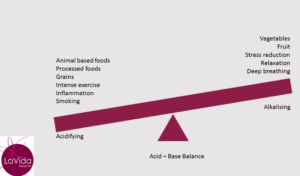A diet low in fibre is a risk factor for bowel cancer, diverticulitis, constipation, haemorrhoids, high cholesterol, heart disease, weight gain and more.
It is easy to forget the importance of dietary fibre when you are inundated with information about important vitamins and minerals, or the latest ‘superfood’. So, while it might not sound very “exciting” (unless you’re a naturopath like me 😉), dietary fibre is vital to your ongoing good health.
What is fibre and why do we need it?
Fibre is the part of your food that can’t be broken down, digested and absorbed through the lining of your intestines into your bloodstream. So, it moves through your colon and forms your stool. It is found in fruit, vegetables, nuts, seeds and legumes. It’s also in grains (especially the outer covering, unfortunately often lost in highly processed foods).
Fibre keeps your digestive tract clean and aids good elimination of waste and toxins through your bowels. It’s like a big broom for your gut.
How much fibre do you need?
The Suggested Dietary Target for fibre as recommended by the National Health and Medical Research Council of Australia is 28 grams for adult women and 38 grams for men. However, this may vary depending on your specific health needs including the state of your gut microbiome. Some people may need more or less so it is wise to work with a naturopath or other health professional to work out what is right for you.
Preferably, fibre should come from a variety of sources (due to the different types of fibre). Just taking a fibre supplement or adding heaps of wheat bran to your cereal on a regular basis is not ideal. You are missing out on the other nutritional benefits of whole food including important phytonutrients and the different types of fibre.
Whole food is the best way to go (when possible), not only for your bowels but for all aspects of your health too!
What are the different types of fibre?
Fibre is generally classified into three different types; soluble, insoluble and resistant starch. Many foods contain a combination of soluble and insoluble fibre. Eating a varied diet that includes whole grains, fruits and vegetables should provide you with the different types of fibre you need to maintain healthy bowel function.
Soluble fibre
Soluble fibre slows down the emptying process of your digestive system, therefore increasing the time it takes for your food to pass through. It is soluble in water (hence the name) and as a result, attracts water and swells in the digestive tract. This ensures your bowel movements are soft, formed and easy to pass.
Soluble fibre helps you feel fuller for longer and maintains steady blood sugar levels. Soluble fibre is in all fruit and some vegetables (such as carrots, onion and broccoli), as well as oats, nuts and legumes.
Insoluble fibre
Insoluble fibre does not dissolve in water and adds bulk or ‘roughage’ to your bowel movements. It passes through your digestive system relatively unchanged and may reduce the incidence of constipation and haemorrhoids.
You can find insoluble fibre primarily in wholegrain products, however, it can also be found in some vegetables, nuts, seeds and some fruit.
Resistant starch
Resistant starch is not easily digested by your digestive enzymes (or at least less so than soluble and insoluble fibre). Consequently, it travels to the large intestine where it feeds the good bowel flora (bacteria in the bowel) and thereby supports the healthy functioning of the bowel.
It is thought to have significant health benefits such as reducing inflammation in the bowel and therefore may reduce your risk of developing bowel cancer or other inflammatory conditions.
Like soluble fibre, resistant starch helps you feel fuller for longer and therefore is useful in healthy weight management and maintaining steady blood glucose levels.
You can find resistant starch in the many high fibre foods already listed, however, the content will vary depending on the processing of these foods. For example, resistant starch is high in slightly green bananas and uncooked rolled oats as well as cooked and cooled potatoes, brown rice and legumes.
How to increase your fibre intake through your diet
You can increase your fibre intake by making a few simple changes to your diet, such as swapping white bread, rice and pasta for wholemeal varieties, adding an extra vegetable or piece of fruit into your day and keeping the skin on your fruits and vegetables (well washed of course).
An example of a high fibre daily menu:
Breakfast – Untoasted muesli, topped with a chopped banana and blueberries
Snack – Carrot sticks with hummus dip and one apple
Lunch – Cooled brown rice and lentil salad with spinach, avocado, tomato, cucumber, parsley, and red onion
Snack – 1 slice of wholegrain rye bread topped with a nut butter spread (such as almond or cashew)
Dinner – Poached chicken with a jacket potato, broccoli and Brussel sprouts
Dessert – Stewed pears (without the added sugar) and coconut/dairy yoghurt
Bear in mind that consuming large amounts of fibre (particularly by way of a supplement) over a long period of time can lead to reduced absorption of certain minerals such as zinc, iron and calcium. Furthermore, it is wise to increase your fibre intake gradually. This gives your body and gut microbiome a chance to adapt to the extra fuel. (Too much too soon can make your symptoms worse). So it really is best to make gradual dietary changes over time rather than just using a fibre supplement to keep things moving.
Finally, don’t overlook the importance of your water intake for keeping things moving too.





